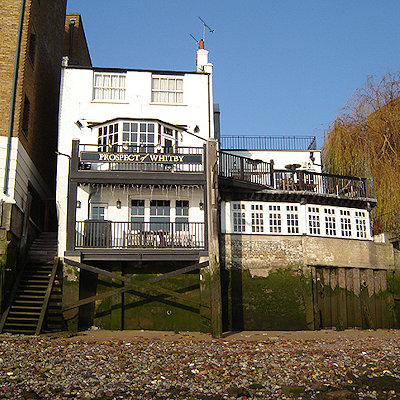
Like us on Facebook
PLACE NAMES


 
|
|
Wapping
|

|
|
|
The area was first settled by Saxons, from whom it takes its name (meaning literally "[the place of] Wæppa's people"). It developed along the embankment of the Thames, hemmed in by the river to the south and the now-rained Wapping Marsh to the north. This gave it a peculiarly narrow and constricted shape, consisting of little more than the axis of Wapping High Street and some north-south side streets. John Stow, the 16th century historian, described it as a "continual street, or a filthy strait passage, with alleys of small tenements or cottages, built, inhabited by sailors' victuallers". A chapel to St. John the Baptist was built in 1617, and it was here that Thomas Rainsborough was buried. Wapping was constituted as a parish in 1694.
Wapping's proximity to the river gave it a strong maritime character for centuries, well into the 20th century. It was inhabited by sailors, mastmakers, boat-builders, blockmakers, instrument-makers, victuallers and representatives of all the other trades that supported the seafarer. Wapping was also the site of 'Execution Dock', where pirates and other water-borne criminals faced execution by hanging from a gibbet constructed close to the low water mark. Their bodies would be left dangling until they had been submerged three times by the tide.
The Bell Inn, by the execution dock, was run by Samuel Batts, whose daughter, Elizabeth, married James Cook in 1762 at Barking, after the Royal Navy captain had stayed at the Inn. The couple initially settled in Shadwell, attending St Paul's church, but later moved to Mile End. Although they had six children together, much of their married life was spent apart, with Cook absent on his voyages and, after his murder in 1779 at Kealakekua Bay, she survived until 1835.
Wapping was devastated by German bombing in World War II and by the post-war closure of the docks. It remained a run-down and derelict area into the 1980s, when the area was transferred to the management of the London Docklands Development Corporation, a government quango with the task of redeveloping the Docklands. The London Docks were largely filled in and redeveloped with a variety of commercial, light industrial and residential properties.
St John's Church (1756) was located on what is now Scandrett Street. Only the tower and shell survived wartime bombing, and have now been converted to housing.
In 1986, Rupert Murdoch's News International built a new printing and publishing works in the north of Wapping. This became the scene of violent protests after News International's UK operation moved from Fleet Street to Wapping, with over 5,000 print workers being sacked when new technology was introduced.
Three venerable public houses are located near the Stairs. By Pelican Stairs is the Prospect of Whitby, which has a much-disputed claim to be the oldest Thames-side public house still in existence and it is certainly one of the most famous public houses in London. It is named after a then-famous collier that used to dock regularly at Wapping. A replica of the old Execution Dock gibbet is maintained on the adjacent foreshore, although the actual site of Execution Dock was nearer to the Town of Ramsgate. This also is on the site of a 16th-century inn and is located next to Wapping Old Stairs to the west of the Prospect; by Wapping Pier Head - the former local headquarters of the Customs and Excise.
Situated halfway between the two is the Captain Kidd, named after the Scottish privateer William Kidd. He was hanged on the Wapping foreshore in 1701 after being found guilty of murder and piracy. Although the pub occupies a 17th-century building, it was established only in the 1980s.
|
 Feel free to Email me any additions or corrections Feel free to Email me any additions or corrections
LINKS AVAILABLE TO YOUR SITE
| |





